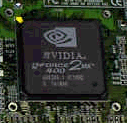 The one BIG thermal downside with this card that I immediately noticed was the absence of good thermal compound between the GPU and the "Blorb". There was some sticky double sided 'thermal tape' but this doesn't really add to much to the whole cooling system. As Thermaltake's "Blob" mounts directly to the PCB, I would really expect to see some silicon thermal compound. Come on OCZ, how could you let that happen?
The one BIG thermal downside with this card that I immediately noticed was the absence of good thermal compound between the GPU and the "Blorb". There was some sticky double sided 'thermal tape' but this doesn't really add to much to the whole cooling system. As Thermaltake's "Blob" mounts directly to the PCB, I would really expect to see some silicon thermal compound. Come on OCZ, how could you let that happen?
Anyway, removing the "Blorb" revealed nVidia's GeForce 2 MX 400 GPU. What's the difference between the GeForce 2 MX, MX200 and MX400?
|
GeForce 2
MX
|
GeForce 2
MX200
|
GeForce 2
MX400
|
|
.18m
|
.18m
|
.18m
|
|
175 MHz
Core
|
175 MHz
Core
|
200 MHz Core
|
|
166 MHz
Mem
|
166 MHz
Mem
|
166 MHz
Mem
|
|
128bit SDR/64bit
DDR
|
64bit SDR
|
128bit SDR/64bit
DDR
|
|
2.7 GB/s
bandwidth
|
1.35 GB/s
bandwidth
|
2.7 GB/s
bandwidth
|
|
350
MPixel/s
|
350
MPixel/s
|
400
MPixel/s
|
|
700
MTexel/s
|
700
MTexel/s
|
800
MTexel/s
|
As shown above, the only difference between the cores of the three nVidia GPU's are that the MX400 core is clocked slightly higher then the other two.
The MX400 has the same speed memory as the others, and same data pathway as the original MX. Of course, nVidia did nothing to address the biggest problem that plagues the GeForce 2 line of cards, namely data bandwidth. Having the same speed memory as the original MX GPU, the MX400, typically won't perform any faster on most games. That's where OCZ steps in with some better-performing parts. The Titan II MX tries to alleviate this by apparently using a little faster RAM.
Now I know it's only a GF2 MX400, but I was interested
on how high I could push it. However this card wasn't too friendly to my
overclocking attempts... The highest stable speed I could get was 220MHz GPU core, 203MHz memory. Not the greatest overclocking attempt, but then again better than no increase at all! Oh well...
Time for some Benchmarks; here are our test system spec's followed by the MX400's competition...
